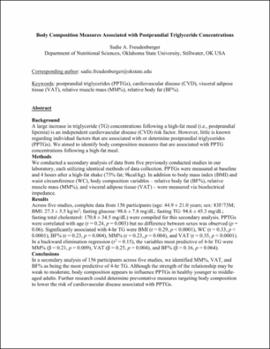| dc.contributor.author | Freudenberger, Sadie A. | |
| dc.date.accessioned | 2022-04-26T19:32:47Z | |
| dc.date.available | 2022-04-26T19:32:47Z | |
| dc.date.issued | 2022-04-11 | |
| dc.identifier | oksd_freudenberger_HT_2022 | |
| dc.identifier.uri | https://hdl.handle.net/11244/335286 | |
| dc.description.abstract | Background: | |
| dc.description.abstract | A large increase in triglyceride (TG) concentrations following a high-fat meal (i.e., postprandial lipemia) is an independent cardiovascular disease (CVD) risk factor. However, little is known regarding individual factors that are associated with or determine postprandial triglycerides (PPTGs). We aimed to identify body composition measures that are associated with PPTG concentrations following a high-fat meal. | |
| dc.description.abstract | Methods: | |
| dc.description.abstract | We conducted a secondary analysis of data from five previously conducted studies in our laboratory, each utilizing identical methods of data collection. PPTGs were measured at baseline and 4 hours after a high-fat shake (73% fat; 9kcal/kg). In addition to body mass index (BMI) and waist circumference (WC), body composition variables - relative body fat (BF%), relative muscle mass (MM%), and visceral adipose tissue (VAT) - were measured via bioelectrical impedance | |
| dc.description.abstract | Results: | |
| dc.description.abstract | Across five studies, complete data from 156 participants (age: 44.9 +/- 21.0 years; sex: 83F/73M; BMI: 27.3 +/- 5.5 kg/m2; fasting glucose: 98.6 +/- 7.8 mg/dL; fasting TG: 94.6 +/- 45.3 mg/dL; fasting total cholesterol: 170.8 +/- 34.5 mg/dL) were compiled for this secondary analysis. PPTGs were correlated with age (r = 0.24, p = 0.003) but no difference between sexes was observed (p = 0.06). Significantly associated with 4-hr TG were BMI (r = 0.29, p < 0.0001), WC (r = 0.33, p < 0.0001), BF% (r = 0.23, p = 0.004), MM% (r = 0.23, p = 0.004), and VAT (r = 0.35, p < 0.0001). In a backward elimination regression (r2 = 0.15), the variables most predictive of 4-hr TG were MM% (B = 0.21, p = 0.009), VAT (B = 0.25, p = 0.004), and BF% (B = 0.16, p = 0.064) | |
| dc.description.abstract | Conclusions: | |
| dc.description.abstract | In a secondary analysis of 156 participants across five studies, we identified MM%, VAT, and BF% as being the most predictive of 4-hr TG. Although the strength of the relationship may be weak to moderate, body composition appears to influence PPTGs in healthy younger to middle-aged adults. Further research could determine preventative measures targeting body composition to lower the risk of cardiovascular disease associated with PPTGs. | |
| dc.format | application/pdf | |
| dc.language | en_US | |
| dc.rights | Copyright is held by the author who has granted the Oklahoma State University Library the non-exclusive right to share this material in its institutional repository. Contact Digital Library Services at lib-dls@okstate.edu or 405-744-9161 for the permission policy on the use, reproduction or distribution of this material. | |
| dc.title | Body composition measures associated with postprandial triglyceride concentrations | |
| osu.filename | oksd_freudenberger_HT_2022.pdf | |
| osu.accesstype | Open Access | |
| dc.type.genre | Honors Thesis | |
| dc.type.material | Text | |
| dc.subject.keywords | postprandial triglycerides (PPTGs) | |
| dc.subject.keywords | cardiovascular disease (CVD) | |
| dc.subject.keywords | visceral adipose tissue (VAT) | |
| dc.subject.keywords | relative muscle mass (MM%) | |
| dc.subject.keywords | relative body fat (BF%) | |
| dc.contributor.director | Emerson, Sam | |
| dc.contributor.facultyreader | Joyce, Jill | |
| thesis.degree.discipline | Nutritional Sciences | |
| thesis.degree.grantor | Oklahoma State University | |
